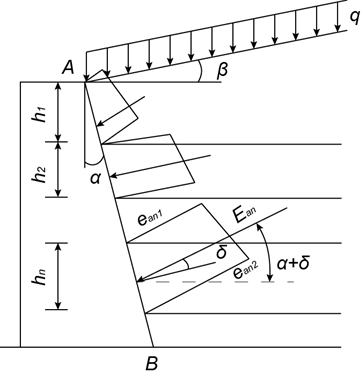Influence of Earthquake according to JTS 146-2012
Only horizontal seismic force is considered according to JTS 146-2012.
Seismic force on structure
Calculation of seismic force acting on structure is as same as JTJ 004-89. Values of Cz can be set from 0.2 to 0.5 suggested by Art. 5.2 in JTS 146-2012.
Seismic earth pressure
 Distribution of seismic active pressure (Fig. 5.3.1)
Distribution of seismic active pressure (Fig. 5.3.1)
The only difference between JTS 146-2012 and JTJ 004-89 is that seismic earth pressure according to JTS 146-2012 considers the influence of cohesion.
Active seismic earth pressure is provided by (Art. 5.3.1):
![]()
where:


![]()

![]()
where: | Ean | - | overall active pressure acting on nth layer [kN/m] |
ean1 | - | active pressure acting on the top of the nth layer [kPa] | |
ean2 | - | active pressure acting on the bottom of the nth layer [kPa] | |
hn | - | thickness of nth layer [m] | |
α | - | back face inclination of the structure [°] | |
Kq | - | coefficient | |
q | - | uniform load acting on the terrain [kPa] | |
γi | - | unit weight of ith layer [kN/m3], below water - buoyant unit weight is accepted | |
hi | - | thickness of the ith layer [m] | |
Kan | - | coefficient of active pressure of nth layer | |
cn | - | standard value of cohesion of nth layer [kPa] | |
Kacn | - | coefficient of seismic active pressure of nth layer | |
β | - | slope inclination [°], and | |
φn | - | internal friction angle of nth layer [°] | |
θ | - | seismic angel [°] | |
δn | - | angle of friction between structure and soil of nth layer [°] |
Passive seismic earth pressure is provided by (Art. 5.3.2):
![]()
where:


![]()

![]()
Seismic angel θ is determined by different options of seismic fortification intensity.
Water influence
Water influence according to Chinese standard is a little different from the water influence according to Mononobe-Okabe or Arrango theory by reducing the water influence using comprehensive influence factor Cz.
Seismic bearing capacity of subsoil
Calculation of seismic bearing capacity of the subsoil is as same as JTJ 004-89.